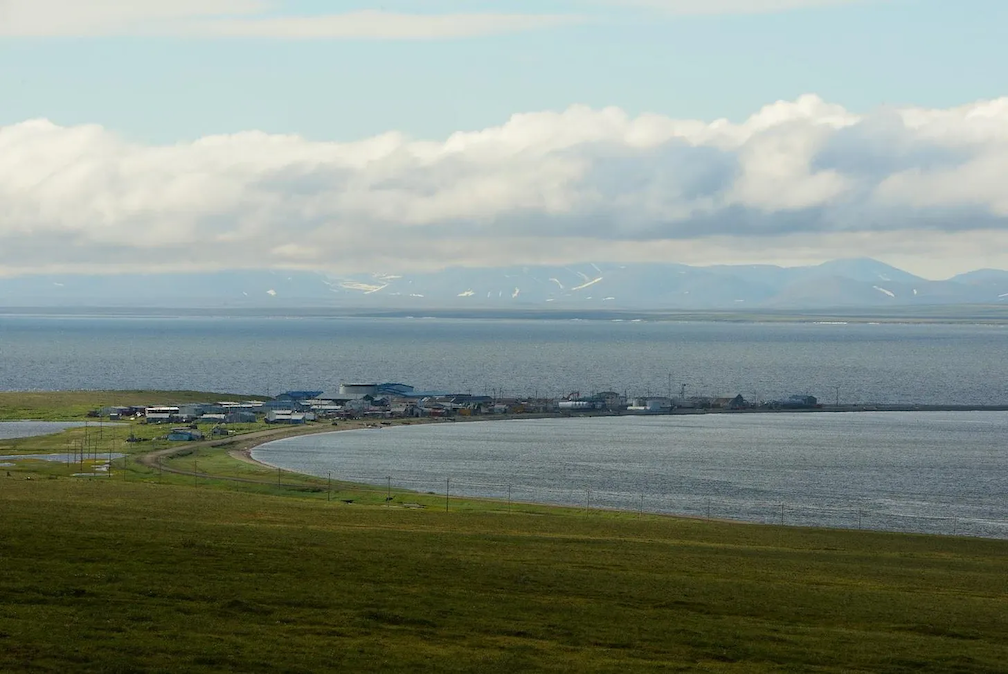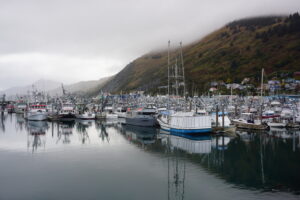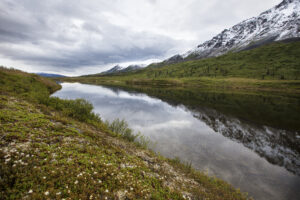12:00
News Story
A new rush arrives on the Seward Peninsula: for graphite, not gold
Graphite is crucial for electrical vehicles, but China controls the global supply. A mine on the Seward Peninsula could help change that — but it’s perched above an essential Iñupiaq subsistence area.
SEWARD PENINSULA — Ducks and swans flew overhead as Sylvester Ayek, 82, and his daughter Kimberly, 35, hauled rocks to anchor their small salmon net on the bank of a deep, tidal channel — 25 miles inland from the open Bering Sea coast.
Nearby on that July day, MaryJane Litchard, Ayek’s partner, picked wild celery and set out a lunch of past subsistence harvests: a blue-shelled seabird egg, dried beluga whale meat and red salmon dipped in seal oil.
Then, as they waited for fish to fill the net, the family motored Ayek’s skiff up the channel, known as the Tuksuk, spotting birds and seals and passing family fish camps where drying salmon hung on racks. Soon, the steep channel walls gave way to a huge estuary: the Imuruk Basin, flanked by the snow-dotted peaks of the Kigluaik Mountains.
Ayek describes the basin as a “traditional hunting and gathering place” for the local Iñupiat, who have long sustained themselves on the area’s bounty of fish, berries and wildlife.
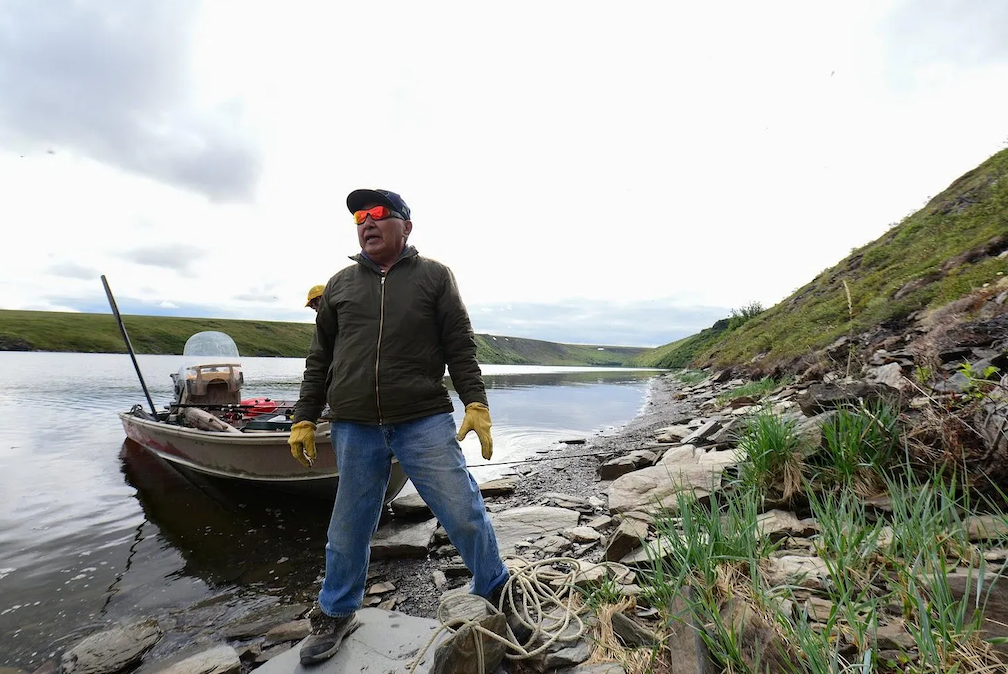

But despite a long Indigenous history, and a brief settler boom during the Gold Rush more than a century ago, a couple of weather-beaten cabins were the only obvious signs of human impact as Ayek’s boat idled — save for a set of tiny, beige specks at the foot of the mountains.
Those specks were a camp run by a Canadian exploration company, Graphite One. And they marked the prospective site of a mile-wide open pit mine that could reach deep below the tundra — into the largest known deposit of graphite in the U.S.
The mine could help power America’s electric vehicle revolution, and it’s drawing enthusiastic support from powerful government officials in both Alaska and Washington, D.C. That includes the Biden administration, which recently announced up to $37.5 million in subsidies for Graphite One through the U.S. Department of Defense.
So far, the announcements from the project’s politically connected boosters have received far more attention than the several hundred Alaskans whose lives would be affected directly by Graphite One’s mine.
While opinions in the nearby Alaska Native villages of Brevig Mission and Teller are mixed, there are significant pockets of opposition, particularly among the area’s tribal leaders. Many residents worry the project will harm the subsistence harvests that make life possible in a place where the nearest well-stocked grocery store is a two-hour drive away, in Nome.

“The further they go with the mine, our subsistence will just move further and further away from us,” Gilbert Tocktoo, president of Brevig Mission’s tribal government, said over a dinner of boiled salmon at his home. “And sooner or later, it’s going to become a question of: Do I want to live here anymore?”
Despite those concerns, Graphite One is gathering local support: Earlier this month, the board of the region’s Indigenous-owned, for-profit corporation unanimously endorsed the project.
The Nome-based corporation, Bering Straits Native Corp., also agreed to invest $2 million in Graphite One, in return for commitments related to jobs and scholarships for shareholders.
The tensions surrounding Graphite One’s project underscore how the rush to bolster domestic manufacturing of electric vehicles threatens a new round of disruption to tribal communities and landscapes that have already borne huge costs from past mining booms.


Across the American West, companies are vying to extract the minerals needed to power electric vehicles and other green technologies. Proposed mines for lithium, antimony and copper are chasing some of the same generous federal tax credits as Graphite One — and some are advancing in spite of objections from Indigenous people who have already seen their lands taken and resources diminished over more than a century of mining.
The Seward Peninsula’s history is a case in point: Thousands of non-Native prospectors came here during the Gold Rush, which began in 1898. The era brought devastating bouts of pandemic disease and displacement for the Iñupiat, and today, that history weighs on some as they consider how Graphite One could affect their lives.

But other Indigenous residents of Brevig Mission and Teller say the villages would benefit from well-paying jobs that could come with the mine. Cash income could help people sustain their households in the two communities, where full-time work is otherwise scarce.
Graphite One executives say one of their highest priorities, as they advance their project toward permitting and construction, is protecting village residents’ harvests of fish, wildlife and berries. They say they fully appreciate the essential nature of that food supply.
“This is very real to them,” said Mike Schaffner, Graphite One’s senior vice president of mining. “We completely understand that we can’t come in there and hurt the subsistence, and we can’t hurt how their lifestyle is.”

U.S. produces no domestic graphite
Graphite is simply carbon — like a diamond but far softer, because of its different crystal structure. Graphite is used as a lubricant, in industrial steelmaking, for brake linings in automobiles and as pencil lead.
It’s also a key component of the high-powered lithium batteries that propel electric cars.
Once mined and concentrated, graphite is processed into a powder that’s mixed with a binder, then rolled flat and curled into the hundreds of AA-battery-sized cylinders that make up the battery pack.
America hasn’t mined any graphite in decades, having been undercut by countries where it’s extracted at a lower cost.
China currently produces more than half of the world’s mined graphite and nearly all of the highly processed type needed for batteries. The country so dominates the supply chain that global prices typically rise each winter when cold temperatures force a single region, Heilongjiang, to shut down production, said Tony Alderson, an analyst at a price tracking firm called Benchmark Mineral Intelligence.
Some forecasts say graphite demand, driven by growth in electric vehicles, could rise 25-fold by 2040. Amid growing U.S.-China political tensions, supply chain experts have warned about the need to diversify America’s sources of graphite.
Last year’s climate-focused Inflation Reduction Act, written in part to wrest control of electric vehicle manufacturing from China, is accelerating that search.
For new electric cars to qualify for a $3,750 tax credit under the act, at least 40% of the value of the “critical minerals” that go into their batteries must be extracted or processed domestically, or in countries such as Canada or Mexico that have free-trade agreements with the United States.
That fraction rises to 80% in four years.
Graphite One is one of just three companies currently advancing graphite mining projects in the United States, according to the U.S. Geological Survey. And company officials are already marketing their graphite to global electric vehicle makers.
But when they presented their preliminary plans to Tesla, “they said, ‘That’s great, we are interested in buying them, but we would need to write 40 contracts of this size to meet our need,’” Schaffner, the Graphite One vice president, said at a community meeting this year, according to the Nome Nugget.
In response, Graphite One is now studying a mine that could be substantially larger than its original proposal.
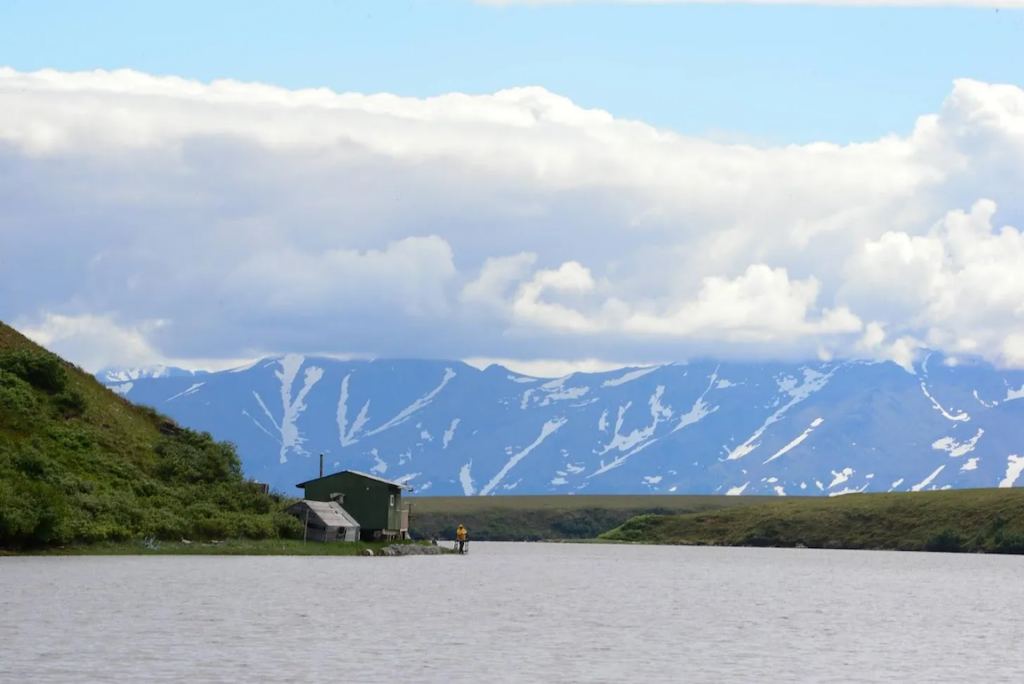
While graphite itself is nontoxic and inert, the company also hasn’t finished studying the acid-generating potential of the rock that its mine could expose — another key indicator of the project’s level of risk. Stronger acid is more likely to release toxic metals into water that Graphite One would have to contain and treat before releasing back into the environment.
One fish biologist in the region has also said he fears the mine’s construction could negatively affect streams flowing out of the Kigluaik Mountains, though Graphite One officials disagree. The streams’ cool water, according to Charlie Lean, keeps temperatures in the shallow Imuruk Basin low enough to sustain spawning salmon — a critical source of abundant, healthy food for Brevig Mission and Teller residents.
Graphite One plans to store its waste rock and depleted ore in what’s known as a “dry stack,” on top of the ground — rather than in a pond behind a dam, a common industry practice that can risk a major breach if the dam fails.
But experts say smaller-scale spills or leaks from the mine could still drain into the basin and harm fish and wildlife.
“There is always a possibility for some sort of catastrophic failure. But that doesn’t happen very often,” said Dave Chambers, president of the nonprofit Center for Science in Public Participation, which advises advocacy and tribal groups across the country on mining and water quality. “There’s also a possibility there will be no impact. That doesn’t happen very often, either.”
Anthony Huston, Graphite One’s chief executive, said his project will incorporate local knowledge and protect residents’ subsistence harvests.
“We are completely focused on making sure that we create a stronger economy, and the entire Bering Straits region, and all of Alaska, for that matter. And that’s something that this project will bring,” he said in an interview. “But it will never bring it at the expense of the traditional lifestyle of Alaska Native people.

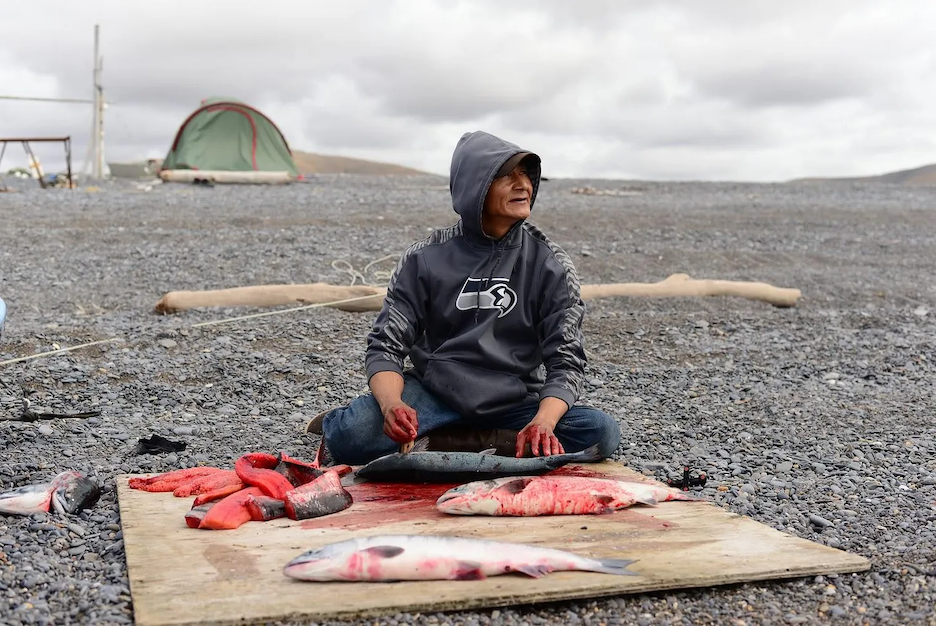
A way of life at stake
There are no Teslas in Brevig Mission or Teller, the two Alaska Native villages closest to the proposed mine.
To get to the communities from the nearest American Tesla dealership, you’d first board a jet in Seattle. Then, you’d fly 1,400 miles to Anchorage, where you’d climb on to another jet and fly 500 more miles northwest to Nome, the former Gold Rush town known as the finish line of the Iditarod sled dog race.
A 70-mile gravel road winds northwest through tundra and mountains before dipping back down to a narrow spit on the Bering Sea coast. The road ends in Teller, population 235, where most residents lack in-home plumbing — let alone own electric cars.
If you need a bathroom here, you’ll use what’s known as a honey bucket.
Brevig Mission, population 435, is even more remote than Teller. It sits across a narrow strait and is accessible only by boat or plane.
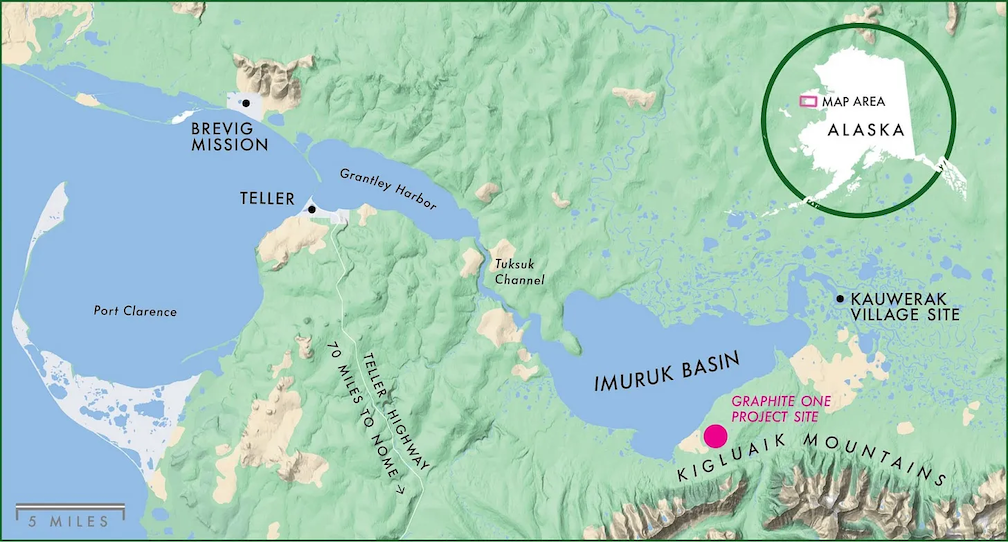
The area was chosen, according to the book, for the same reasons it’s treasured now: abundant fish and birds, berries and moose, even beluga whales. Kauwerak became one of the Seward Peninsula’s largest villages before it was abandoned in the 19th century, as residents left for jobs and schools.
Whalers, then gold miners, brought profound changes to the Indigenous way of life on the Seward Peninsula, especially through the introduction of pandemic diseases. One outbreak of measles and flu, in 1900, is thought to have killed up to one-third of residents in one of the region’s villages. In Brevig Mission, 72 of 80 Native residents died from the 1918 Spanish flu.
Today, the miners and whalers are gone. In Teller, the population of 250 is 99% Alaska Native.
Four in 10 residents there live below the poverty level, and a typical household, with an average of three people, survives on just $32,000 a year, according to census data.
At the community’s main store, the shelves are completely barren of fresh fruits and vegetables. A box of Corn Chex costs $9.55, and a bottle of Coffee-Mate runs $11.85 — more than twice the Anchorage price.
Residents can buy cheaper groceries in Nome. But gas for the 70-mile drive costs $6.30 a gallon, down from $7 in July.
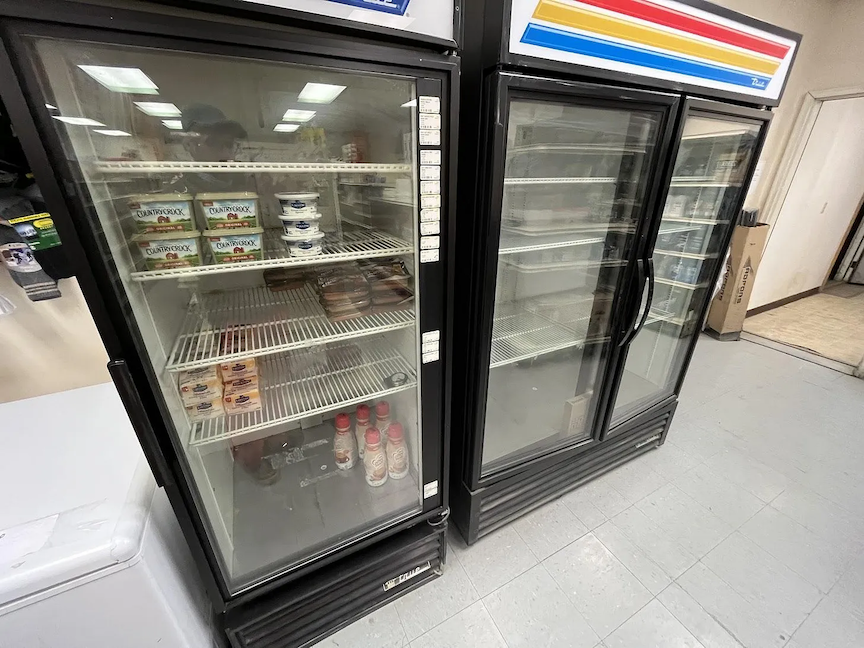
As Ayek, the 82-year-old subsistence fisherman, pulled his skiff back into Teller with a cooler of fish, another man was slicing fresh sides of salmon a little ways down the beach.
Nick Topkok, 56, has worked as a contractor for Graphite One, taking workers out in his boat. As he hung his fish to dry on a wood rack, he said few people in the area can find steady jobs.
“The rest are living off welfare,” Topkok said. The mine, he said, would generate money for decades, and it also might help get the village water and sewer systems.
“I’ll be dead by then, but it’ll impact my kids, financially,” he said. “If it’s good and clean, so be it.”
Topkok also acknowledged, however, that a catastrophic accident would “impact us all.”
Many village residents’ summer fishing camps sit along the Tuksuk Channel, below the mine site. Harvests from the basin and its surroundings feed families in Brevig Mission and Teller year-round.
“It’s my freezer,” said Dolly Kugzruk, president of Teller’s tribal government and an opponent of the mine.
Researchers have found all five species of Pacific salmon in and around the Imuruk Basin. Harvests in the area have hit 20,000 fish in some years — roughly 30 per fishing family, according to state data.
At a legislative hearing several years ago on a proposal to support Graphite One’s project, one Teller resident, Tanya Ablowaluk, neatly summed up opponents’ fears: “Will the state keep our freezers full in the event of a spill?”

Gold Rush prospector’s descendants would reap royalties
Elsewhere in rural Alaska, Indigenous people have consented to resource extraction on their ancestral lands on the basis of compromise: They accept environmental risks in exchange for a direct stake in the profits.
Two hundred miles north of the Imuruk Basin, zinc and lead unearthed at Red Dog Mine have generated more than $1 billion in royalties for local Native residents and their descendants, including $172 million last year. On the North Slope, the regional Iñupiat-owned corporation receives oil worth tens of millions of dollars a year from developments on its traditional land.
The new Manh Choh mine in Alaska’s Interior will also pay royalties to Native landowners, as would the proposed Donlin mine in Southwest Alaska.
No such royalties would go to the Iñupiaq residents of Brevig Mission and Teller, based on the way Graphite One’s project is currently structured.
The proposed mine sits exclusively on state land. And Graphite One would pay royalties to the descendants of a Gold Rush-era prospector — a legacy of the not-so-distant American past when white settlers could freely claim land and resources that had been used for thousands of years by Indigenous people.
Nicholas Tweet was a 23-year-old fortune seeker when he left Minnesota for Alaska in the late 1800s. His quest for gold, over several years, took him hiking over mountain ranges, floating down the Yukon River by steamboat, walking hundreds miles across beaches and, finally, rowing more than 100 miles from Nome in a boat he built himself.
Tweet settled in Teller with his family, initially prospecting for gold.
As graphite demand spiked during World War I, Tweet staked claims along the Kigluaik Mountains, and he worked with a company that shipped the mineral to San Francisco until the war ended and demand dried up.
Today, Tweet’s descendants are still in the mining business on the Seward Peninsula. And they still controlled graphite claims in the area a little more than a decade ago. That’s when Huston, a Vancouver entrepreneur, was drawn into the global graphite trade through his interest in Tesla and his own graphite-based golf clubs.
News of a possible deal with Huston’s company arrived at one of the Tweets’ remote mining operations via a note dropped by a bush plane. They reached an agreement after months of discussions — sometimes, according to Huston, with 16 relatives in the room.
So far, the Tweet family, whose members did not respond to requests for comment, has received $370,000 in lease fees. If the project is built, the family would receive additional payments tied to the value of graphite mined by Graphite One, and members could ultimately collect millions of dollars.
Bering Straits Native Corp., owned by more than 8,000 Indigenous shareholders with ties to the region, recently acquired a stake in Graphite One’s project — but only by buying its way in.
The company announced its $2 million investment this month. The deal includes commitments by Graphite One to support scholarships, hire Bering Straits’ shareholders and give opportunities to the Native-owned corporation’s subsidiary companies, according to Dan Graham, Bering Straits’ interim chief executive. He declined to release details, saying they have not yet been finalized.
As it considered the investment, Bering Straits board members held meetings with Brevig Mission and Teller residents, where they heard “a lot of concerns,” Graham said. Those concerns “were very well thought through at the board level” before the corporation offered its support for the project, he added.
“Graphite One is very committed to employing local workers from those villages, to being as transparent as possible on what the development is,” Graham said.
Graphite One officials say they have work to do to ensure the region’s residents are trained for mining jobs in time for the start of construction. The company had a maximum of 71 people working at its camp this summer, but Graphite One and its contractors hired just eight people from Teller and Brevig Mission. Sixteen more were from Nome and other villages in the region, according to Graphite One.
Company officials say they have no choice but to develop a local workforce. Because of graphite’s relatively low value in raw form, compared to gold or copper, they say the company can’t afford to fly workers in from outside the region.
Graphite One says it’s also taking direction from members of a committee of local residents it’s appointed to provide advice on environmental issues. In response to the committee’s feedback, the company chose not to barge its fuel through the Imuruk Basin earlier this year; instead, it flew it in, at an added cost of $4 a gallon.
Since Graphite One acquired the Tweets’ graphite claims, progress on the development has been slow. But now, escalating tensions with China and the national push to Americanize the electric vehicle supply chain are putting Huston’s project on the political fast track.
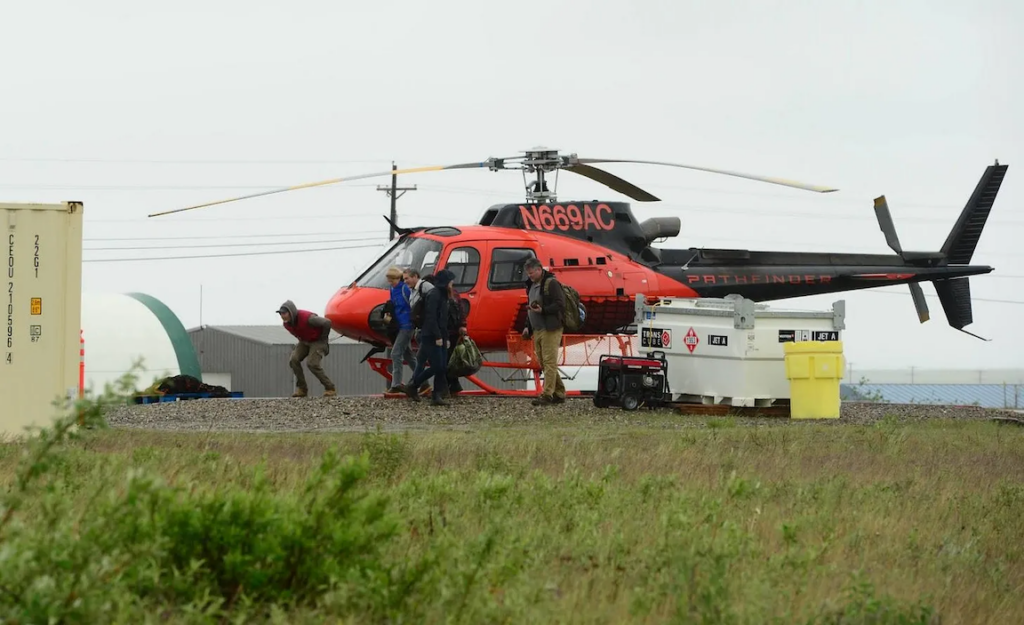
‘We don’t have a choice.’
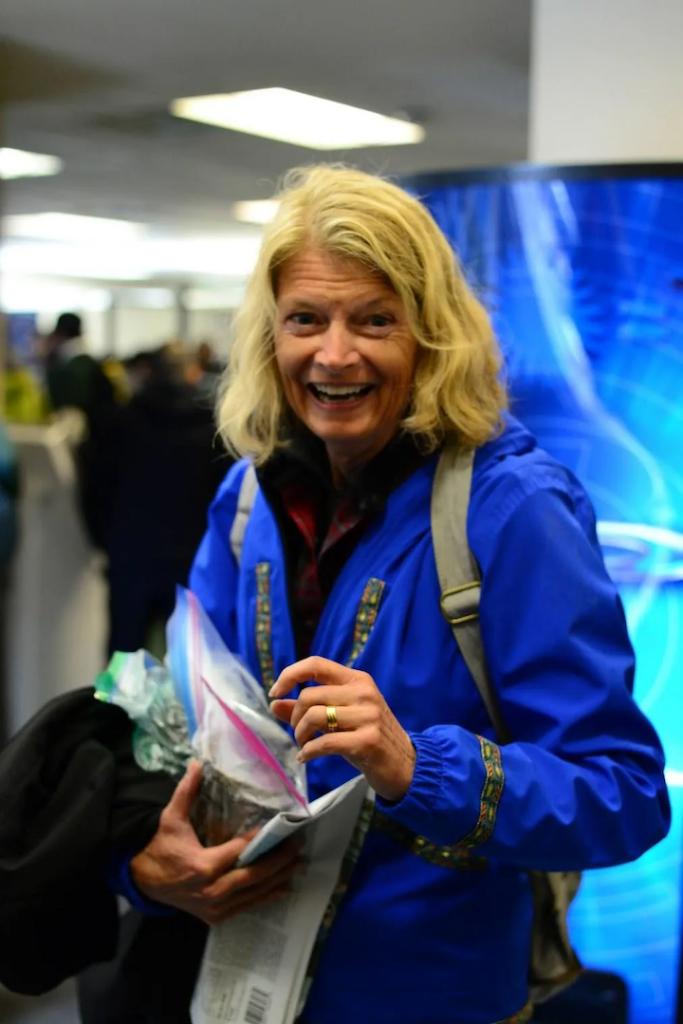
A few days later, the Alaska Republican stood on the Senate floor and brandished what she described as a hunk of graphite from an “absolutely massive,” world-class deposit.
“After my site visit there on Saturday, I’m convinced that this is a project that every one of us — those of us here in the Congress, the Biden administration — all of us need to support,” she said. “This project will give us a significant domestic supply, breaking our wholesale dependence on imports.”
U.S. Sen. Dan Sullivan, R-Alaska, U.S. Rep. Mary Peltola, D-Alaska, and GOP Gov. Mike Dunleavy have all expressed support for the project.
Graphite One has enlisted consultants and lobbyists to advance its interests, according to disclosure filings and emails obtained through public records requests.
They include Clark Penney, an Anchorage-based consultant and financial advisor with ties to the Dunleavy administration, and Nate Adams, a former employee of Murkowski and Sullivan who’s worked as a lobbyist in Washington, D.C.
Murkowski has said the mine will reduce dependence on foreign countries that lack America’s environmental and human rights safeguards.
“Security of supply would be assured from day one, and the standards for the mine’s development and operation would be both exceedingly high and fully transparent,” Murkowski wrote in a letter to the Biden administration in 2022.
The Defense Department, meanwhile, announced its grant of up to $37.5 million for Graphite One in July. This month, the company also announced it had received a $4.7 million Defense Department contract to develop a graphite-based firefighting foam.
In a statement, a department spokesman said the July agreement “aims to strengthen the domestic industrial base to make a secure, U.S.-based supply of graphite available for both Department of Defense and consumer markets.”
In Teller and Brevig Mission, Graphite One’s opponents have noticed how the electrical vehicle transition seems to be driving interest in the mine planned for nearby.

Tocktoo, the chief of Brevig Mission’s tribal council, said resistance in his community has diminished as Graphite One “tries to buy their way in.”
The company awards door prizes at meetings and distributes free turkeys, he said. Two years ago, the company gave each household in Brevig Mission and Teller a $50 credit on their electrical bills.
The project, though, remains years away from construction, with production starting no earlier than 2029.
Before it can be built, Graphite One will have to obtain an array of permits, including a major authorization under the federal Clean Water Act that will allow it to do construction around wetlands.
And the project also faces geopolitical and economic uncertainties.
At least last year, Graphite One was tight on cash. It had to slightly shorten its summer exploration season because it didn’t have the money to finish it, company officials said at a public meeting this year.
And while Graphite One is counting on a partnership with a Chinese business to help set up its graphite processing and manufacturing infrastructure, the partner company’s top executive has said publicly that U.S.-China political tensions may thwart the transfer of necessary technologies.
Murkowski, in an interview at the Nome airport on her way home from her visit to Graphite One’s camp, stressed that the project is still in its very early stages.
The permitting process and the substantial environmental reviews that will accompany it, she added, will give concerned residents a chance to pose questions and raise objections.
“There’s no process right now for the public to weigh in. And it’s all so preliminary,” she said. “When you don’t know, the default position is, ‘I don’t think this should happen.’”

“It just feels like we have nothing to say about it. We don’t have a choice,” Oquilluk said. “They’re going to do it anyways, no matter what we say.”
Correction: This article has been updated to more precisely describe the salinity in the Imuruk Basin and to delete an incorrect space in MaryJane Litchard’s first name.
This story was produced by Northern Journal, APM Reports and Alaska Public Media as part of the Public Media Accountability Initiative, which supports investigative reporting at local media outlets around the country.
Nathaniel Herz welcomes tips at [email protected] or (907) 793-0312. This article was originally published in Northern Journal, a newsletter from Herz. Subscribe at this link.
Our stories may be republished online or in print under Creative Commons license CC BY-NC-ND 4.0. We ask that you edit only for style or to shorten, provide proper attribution and link to our website. AP and Getty images may not be republished. Please see our republishing guidelines for use of any other photos and graphics.
